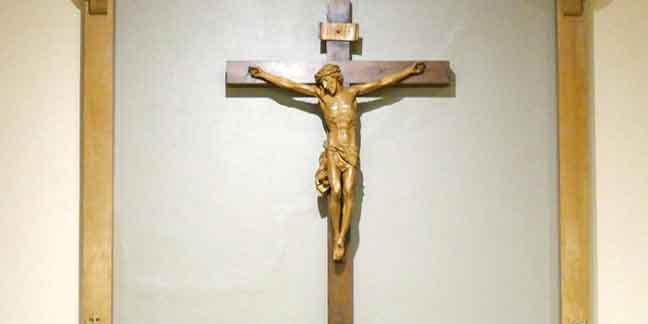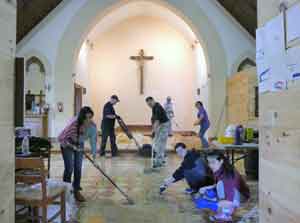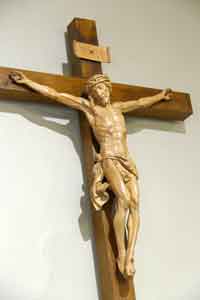 WAYNESVILLE — After St. John the Evangelist Parish dedicated our new church in 2007, the old 1940s-era church fell into disuse. Over the next decade, the old pews were sold to raise money, the parish youth group took over the top floor, and the bottom floor eventually became the Knights Hall. Through all these years, a crucifix remained hanging on the wall above the former altar – mostly unnoticed, gathering dust.
WAYNESVILLE — After St. John the Evangelist Parish dedicated our new church in 2007, the old 1940s-era church fell into disuse. Over the next decade, the old pews were sold to raise money, the parish youth group took over the top floor, and the bottom floor eventually became the Knights Hall. Through all these years, a crucifix remained hanging on the wall above the former altar – mostly unnoticed, gathering dust.
Fast forward to October 2016. One parishioner remembered the crucifix and longed for it to once again be included in worship at our parish. The new church already had a beautiful, large crucifix. Our parish’s mission, Immaculate Conception in Canton, had a small crucifix. So St. Joseph Sister Mary Ruth Masters asked, “Why don’t we move this big, beautiful crucifix to Immaculate Conception? I always loved seeing that crucifix in the old church, and I was disappointed when it wasn’t moved to the new church.”
Sister Mary Ruth went to her friend and fellow parishioner, Gail Webb, who also loved the idea of restoring the crucifix for the Canton church. She called Immaculate Conception parishioner Tom Langan, a retired folk artist from Long Island, N.Y., and a devout Catholic. He had already demonstrated his skill and commitment when he carved a Paschal Lamb for the altar at Immaculate Conception Mission.
Langan met with Father Christopher Riehl, parish administrator, and then enlisted the assistance of three more parishioners – Jim McGovern and Gary Lepak from Immaculate Conception, and me. While the others met with Father Riehl to discuss the plans, I set about researching the history of  this crucifix. Father Riehl referred me to King Richard’s Liturgical Design and Contracting, in Alpharetta, Ga. King Richard’s asked that we send photos and measurements of the crucifix, and they would see what they could learn.
this crucifix. Father Riehl referred me to King Richard’s Liturgical Design and Contracting, in Alpharetta, Ga. King Richard’s asked that we send photos and measurements of the crucifix, and they would see what they could learn.
King Richard’s responded quickly. Based on the slender form and clear finish of the crucifix, it almost certainly was carved between 1930 and 1960, as that was the trend at the time. The crucifix depicts Our Lord at the moment of His death, as there is no lance wound in His side. But the real clue to its origin is the unique “INRI” panel at the top of the cross. It is only seen on crucifixes carved in Ortesei, Italy, and specifically by the Demetz Studio located there. Founded in 1872, the Demetz Studio is one of the world’s leading manufacturers of ecclesiastical art, and it uses traditional local carving methods. Today the fifth generation of Demetz carvers is carrying on the family business.
It was obvious that our parish had something special in this crucifix.
 Father Riehl granted permission to move the crucifix to Immaculate Conception Mission. It was taken down from the old church’s sanctuary wall and transported to Langan’s studio. Upon close inspection, they learned that one of the fingers on the right hand was broken and missing, so Langan carved and attached a perfect replacement. He then carefully and lovingly cleaned the cross and corpus, stained the cross, and sealed the wood of the corpus. The result was a beautiful representation of Our Lord’s crucifixion, of His suffering and sacrifice on the cross.
Father Riehl granted permission to move the crucifix to Immaculate Conception Mission. It was taken down from the old church’s sanctuary wall and transported to Langan’s studio. Upon close inspection, they learned that one of the fingers on the right hand was broken and missing, so Langan carved and attached a perfect replacement. He then carefully and lovingly cleaned the cross and corpus, stained the cross, and sealed the wood of the corpus. The result was a beautiful representation of Our Lord’s crucifixion, of His suffering and sacrifice on the cross.
All of us met at Immaculate Conception, removed the small crucifix that had been hanging there, and installed the Demetz Crucifix above the altar.
The Demetz Crucifix creates a beautiful focal point for worship in the small mission church. When Sister Mary Ruth first saw the crucifix over the altar at Immaculate Conception, she said, “I couldn’t take my eyes off of it. It was even more beautiful than it was in the old church. I knew that it was now exactly where it belonged.”
— Phil Webb, Special to the Catholic News Herald. Phil Webb is a parishioner at St. John the Evangelist Church in Waynesville.



